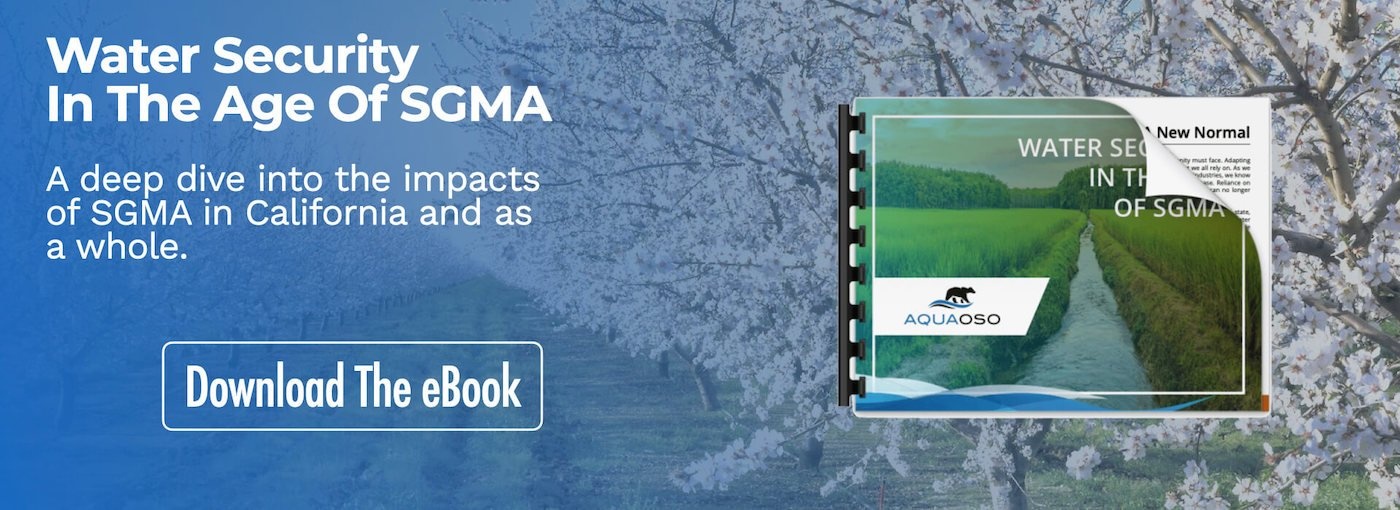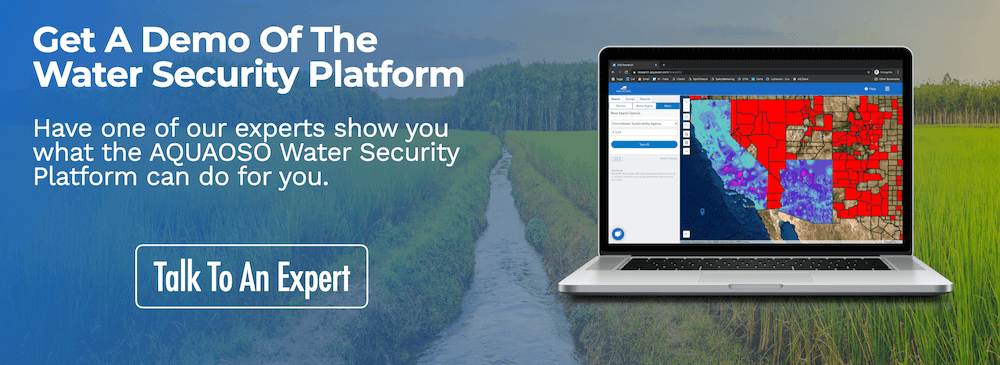Farm Investment – How Water Risk Plays A Key Role
Farm investment is intrinsically linked to ensuring a reliable food supply now and into the future (especially in developing countries) but also in water-scarce regions of the U.S. According to the FAO,
“Agricultural development depends on the simultaneous growth of farm-level production and productivity and the value chains to which it is linked.”
In other words, financial funding is an important part of what makes agriculture happen; investments help build stable supply chains, provide bride solutions for commodity price swings and/or crop failure as well as helping develop more efficient technologies for crop production. Growers are still limited by environmental constraints, though – specifically in terms of access to land and water – and if any of these resources are in question, all stakeholders in a land deal are at risk. Therefore, understanding water risk is key to making sound, sustainable investments that can provide a consistent ROI over time.
This article takes a look at the role that water risk plays in farm investments, and where the data to make better investment decisions can be found.
(Part of our Agriculture Investing Guide)
In Farm Investment, Water Risk = Business Risk
Some of the most important crops on the market have a hidden water footprint that can be easy to overlook in times of water abundance but may turn into a serious business risk in times of water scarcity. Ceres.org explains how high the stakes are:
“A staggering 15,000-plus liters of water are required for one kilogram of beef, 10,000 liters for cotton. Even the humble potato requires over 280-plus liters. Abundant clean water is also essential to food processing – for cleaning and moving raw materials, as an ingredient, and as the principal agent used in sanitizing plant machinery.”
There’s almost no part of the supply chain that doesn’t rely on water in some way, and when water is scarce, it almost always translates to business risk. In these scenarios, farmers may struggle to maintain their operations without an adequate supply of water, and procuring water rights via a private sale or smart water market may present challenges of its own.
One potential outcome is decreased productivity, as growers are forced to let fields go fallow or plant less water-intensive crops. Another is reputation risk, as companies are perceived to be “competing with local communities for access to water supplies,” explains Ceres, and putting short-term profits ahead of sustainable water use.
Meanwhile, some watersheds are responding to increased demand by enacting stricter regulations that investors will also have to factor into their risk assessments.
How Water Risk Plays A Key Role in Farm Investment
Franklin Templeton Investments argues that water scarcity and other issues associated with climate change impacts “can no longer be ignored or be considered latent risks just because many believe they are priced too far out or they will not impact portfolios until a point in the distant future…. We must recognize that broader environmental risks are beginning to pose business-relevant vulnerabilities today.”
These risks are only going to increase in the face of climate-related weather events and increasing water shortages.
Investors will need to have a more complete understanding of what they’re investing in – starting with the right water data. If investors make an investment into a farm or a parcel of land that isn’t water-secure, then they risk being tied to an investment that can’t withstand a drought or changing growing conditions.
A report on the Principles of Responsible Investing (PRI) notes that this is often easier said than done: “While some companies may have direct ownership of farms (vertical integration) or direct contracts with farms where crops are grown, others source from commodities traders and on global commodity markets.”
Investors who don’t monitor the water risk of farms and suppliers will be at greater risk than those who do. Investors should take water risk assessments at every level of the supply chain, and account for regional differences in water stress and drought risk.
Why Investors Need the Right Water Data – and What That Data Is
Knowing what information is needed and discerning how to access it is where many investors struggle. Supply chains are incredibly complex, and even a straightforward concept like water risk or water rights can be hard to pin down. The Franklin Templeton analysis points out that water may be measured and assessed differently depending on whether it’s surface water, groundwater, or rainwater:
“One liter of water may be in a river and be used to generate hydropower as it moves through a dam. Downstream, it can be pumped out by a community for municipal use, used, then treated again and discharged back into the river. Further downstream, it can be diverted for irrigation of crops.”
Even then, junior water rights holders may be required to limit their use in favor of more senior users. And in some basins, groundwater pumping may be capped to encourage aquifer recharge.
As a result of a scenario such as this, getting a complete picture of water availability may require:
- looking up water rights in a state-specific online query system
- monitoring current drought conditions in a particular region
- viewing a geospatial map of a groundwater basin
- Understanding natural and manmade water storage capacity/levels (think snowpack, reservoir, etc.)
Additionally, in California, in order to adhere to SMGA’s regulations, ag professionals may have to fill out a detailed report with data on total acreage, plantings, well use, and more.
How AQUAOSO Can Help
Gathering all of this information for farm investments can be a tedious and time-consuming process. AQUAOSO has designed a comprehensive Water Security Platform that can assist in:
- Acquiring more land
- Improving risk decisions
- Enhancing relationships
- Monitoring your portfolio
The Research Tool is a geospatial mapping tool that can be used to view specific parcels of land or the boundaries of a groundwater basin, up-to-date records on land ownership and water rights from multiple regional databases, and more.
The water security dashboard can be used to monitor investments on an ongoing basis and as an aid in compliance with water use regulations. Plus, data can be easily shared with other stakeholders to improve professional relationships and reduce data collection and paperwork.
Read more about water risk in agriculture investment in our explorable guide.
The Bottom Line
AQUAOSO is more than just a database: we provide accurate information with the tools you need to put water risk data into action. AQUAOSO’s cloud-based Water Security Platform is designed to increase investors’ understanding of water risk and, in doing so, give investors a competitive edge.
Browse our resources page to learn more about current water trends and other issues impacting agriculture today, or contact us directly for a free product demo!
Recent Posts
Decision Support Fintech Can Save Ag Lenders Time and Money
The modern financial business landscape is full of tough decisions, many of which are time-sensitive. The most valuable asset for making smart business decisions is being well informed. Unfortunately, given the vast amount of necessary but siloed decision support...
4 Factors of A Portfolio Footprint in Agricultural Finance
21st-century data and risk management technologies in agricultural finance are kingpins of optimizing loan portfolios. One example of this is the enhancement of a business’s ability to track a portfolio footprint. It’s becoming more and more common for businesses and...
How Data Acclimation Enhances Resilience Planning in Agricultural Finance
Financial institutions have a job to do: manage risk. Managing and reducing risk requires resilience planning, a practice that becomes increasingly easier with better access to the right risk datasets. The fluidity of data usage and utility also plays a key role. ...






